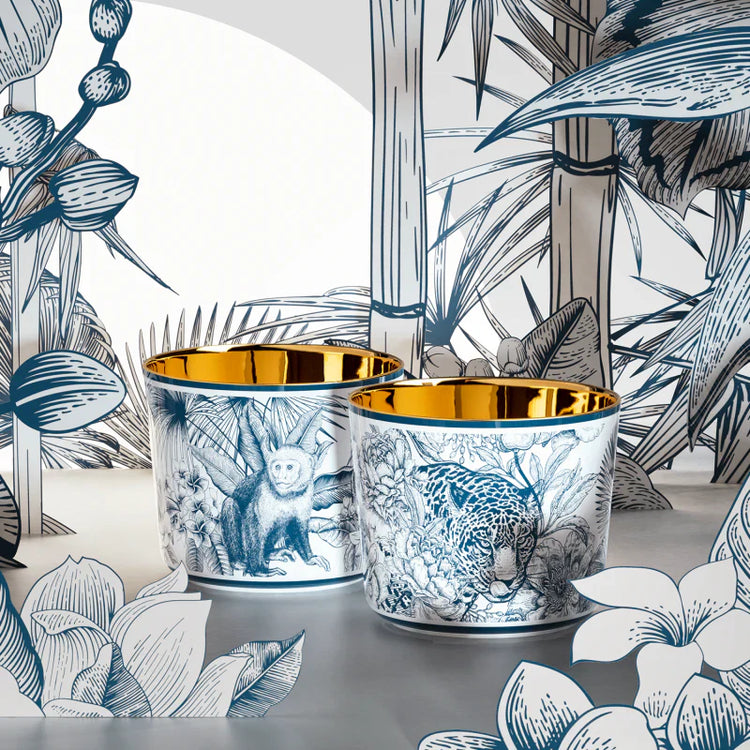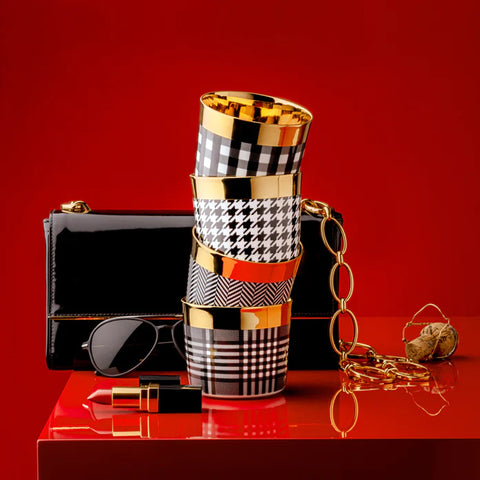SIEGER by FÜRSTENBERG – Porcelain art is the symbiosis of two German master disciplines: centuries-old manufacturing tradition from Fürstenberg and the avant-garde sense of form of the SIEGER design studio. Every cup, every plate, and especially the celebrated "Sip of Gold" mugs undergo over 100 processes before leaving the Weserbergland region – from hand-casting to high-firing at 1,400°C to the 24-carat gold plating. The result is a wafer-thin porcelain body whose metallic shimmering interior illuminates champagne, whiskey, or matcha like liquid light. Thanks to food-safe precious metal plating, EU Ecolabel-certified colors, and dishwasher-safe sealing, SIEGER by FÜRSTENBERG offers not only photographic glamour but also everyday durability. Those who value “Quiet Luxury” will find a design statement here that combines minimalism, sustainability, and sensory perfection in one object – ready to transform the dining table into a stage and every sip into an experience.
Fürstenberg Champagne Glasses – Tradition in your hand, future on your lips
When you lift a Fürstenberg champagne glass for the first time, something happens that has little to do with statistics and all the more to do with sensuality: The fine porcelain shards provide a stage for the sparkling wine, where every bubble shines like a micro-spotlight. This is no coincidence, but rather the result of manufacturing expertise dating back to 1747. In that year, Duke Carl I of Brunswick-Wolfenbüttel founded Northern Germany's first porcelain manufactory in Fürstenberg on the Weser River. To this day, all vessels made there—between the Weser Valley and the Solling Forests—are cast, glazed, and fired twice by hand.
The raw material consists of kaolin from Thuringia, feldspar from the Vosges Mountains, and quartz from Bavaria. After the first firing at around 950 °C, the so-called bisque firing, the Fürstenberg champagne goblet acquires its basic strength. Only then does the glaze follow, followed by the glost firing at approximately 1,400 °C, which transforms the surface into an almost glassy state—hard, dense, and translucent. This specific temperature curve has been the manufacturer's secret recipe for centuries and ensures that the vessel absorbs neither odor nor flavor molecules.
Particular attention is paid to the rim. For Champagne, Fürstenberg has established a precise, angular thin wall of approximately 1.5 mm; this line has been blind-tasted multiple times in the in-house laboratory. The result: A narrow, sharply defined rim spreads the wine fan-like across the tongue, allowing sweetness, acidity, and the delicate brioche notes to be perceived simultaneously. Sommeliers from the Champagne houses Taittinger and Roederer use Fürstenberg cups in sensory workshops because the porcelain wall—unlike glass—transmits temperature fluctuations much more slowly.
Each cup undergoes up to 100 quality control stages: a light table, a sound test (a bell-like, long "ping" indicates perfect density), and manual polishing. Only then is the object allowed to leave the historic production hall. For editions with real gold applications, the manufactory cooperates with German precious metal mills that roll 24-carat gold onto wafer-thin sheets of 0.1 µm. These sheets are applied by specially trained painters with ermine brushes, matte in soot over an open flame, and fired a third time – the so-called luster firing imbues the metallic luster deep into the pores. This creates a Fürstenberg champagne glass whose gold decorations won't dull even after a thousand washes.
Culturally, the cups represent a Franco-German liaison: The shape is Prussian-structured, the idea of sparkling wine is cheerfully French. Fürstenberg explores this tension in its campaigns: A cup rests on rough Weser sandstone, surrounded by grape vines from Champagne – a visual language that blends material and enjoyment. No wonder gourmet magazines like "Falstaff" praised the 2023 cup as "sensorially and visually superior."
Once you hold the object in your hand, you'll understand that luxury here doesn't mean volume, but depth of field. The Fürstenberg champagne goblet is a canvas, a resonant body, and a ritual amplifier all in one – a silent homage to 275 years of porcelain perfection.
Fürstenberg by SIEGER – When design poetry meets manufacturing precision
When the German design studio SIEGER, led by creative director Michael Sieger, and the Fürstenberg porcelain manufacturer joined forces in 2005, the term "brand collaboration" wasn't yet a buzzword, but rather a risky venture. Fürstenberg by SIEGER posed the question: Can centuries-old craftsmanship be translated into the rhythm of the present without betraying its essence? The answer remains yes – in the form of collections that reconcile purism with opulence.
SIEGER brought an architectural precision, evident in the clear volumes of cylinders, spheres, and cones. Fürstenberg, on the other hand, contributed the artisanal DNA: a porcelain that refracts light almost like silk. Their first joint line was called "My China!" and featured cups, bowls, and plates with walls so thin that they allowed for paper-cutting. Today, "My China!" is considered a German design classic and is part of the permanent collection of the Badisches Landesmuseum.
In 2024, the joint portfolio consists of three main lines: Coupé , Cylinder , and Sip of Gold . The latter embodies the quintessence of the collaboration: linear cups, the interior entirely lined with 24-carat gold or platinum, and the exterior in velvety matte shades such as "Azure," "Vermilion," or "Jet Black." Each cup reflects the ambient light, allowing sparkling champagne to shimmer like liquid gold.
Material Facts: The precious metal layer is applied using a manual plating process – a process that fuses at temperatures around 800°C. This creates a 99.9% pure gold surface of approximately 0.2 µm, which is food-safe and dishwasher-safe. According to the company's own test reports, the coating withstands over 800 dishwashing cycles without visible abrasion.
In terms of design, SIEGER reduces ornamentation to micro-gestures: laser-engraved typography on the cup's base, a fine bevel that provides grip for fingertips. The interplay of the material exterior and the metal interior creates an "interior glow" that fills the room in subdued light. At events like the Paris "Maison&Objet" in 2023, crowds gathered around the trade fair podium because visitors wanted to film the light-mirror effect.
The Fürstenberg by SIEGER line is also a study in circularity: Gold and platinum scraps from offcuts are collected, melted down, and reused. This reduces precious metal waste by up to 40%, as the manufacturer's sustainability reports show. At the same time, the production process carries the EU Ecolabel, as only low-pollutant pigments and solvent-free carriers are used.
The aesthetics of Fürstenberg by SIEGER reflect a truly moral modernity: beauty, yes, but not at the expense of the environment and craftsmanship. Owning such a mug not only carries design history in their hands, but also a commitment to longevity and resource conservation.
SIEGER by Fürstenberg tumblers – icons for champagne, whiskey and matcha
During the collaboration's world tour, the order of the words has sometimes been reversed: When talking about pure object cult, SIEGER by Fürstenberg mugs often come up. This usually refers to the pieces from the "Sip of Gold" series. The mugs hold 0.28 liters, fit perfectly between your thumb and middle finger without a handle, and are double-walled to prevent condensation.
They owe their popularity not only to luxury restaurants, but also to pop culture. In 2019, a gold cup appeared in a Berlin rapper's music video; on Instagram, the hashtag #sipofgold is circulating in over 35,000 posts. The cups are just as suitable for Old Fashioneds as they are for iced matcha—the metallic interior reflects any liquid, creating a true spectacle.
Facts for purists: The net weight of a SIEGER by Fürstenberg mug is approximately 270 g, the wall thickness is 2 mm, and tolerances are less than 0.1 mm. Each mug has a precisely polished base ring; thanks to a micro-bevel, the rim doesn't cut into the lip. Rolling Pin restaurant tests confirmed a shock resistance that far exceeds glassware.
For collectors, SIEGER annually publishes "Faces of the Year" – Artist Editions, in which porcelain artists apply illustrations of David Bowie or Salvador Dalí as wafer-thin transfers. In 2022, the edition was limited to 500 pieces, numbered and signed by Michael Sieger. The edition sold out within 48 hours; at auction, a Bowie mug has already fetched three times its list price.
The series is also a lesson in color psychology. Dark exteriors like "Midnight Blue" contrast the gold interior, while pastel colors like "Blush" create a delicate transition. Interior designers place two or three mugs on sideboards because they function as light objects even when empty.
The cups have even gained a foothold in haute cuisine. Three-star chef Christian Bau serves Tasmanian pepper consommé in them; the steam hits the cold gold wall and reflects the ambient light—a culinary theatrical act. Food photographs prove that the gold coating makes any liquid camera-friendly, as it smooths out hot spots and intensifies colors.
In short, a SIEGER by Fürstenberg mug transforms drinking into a ritual. It's a sculpture, a reflector, a statement—yet practical enough for everyday use, even for an espresso macchiato.

Gold Champagne Goblets – Between Art Deco Glamour and Digital Modernity
The term "gold champagne flute" evokes Hollywood fantasies: Gatsby parties, Art Deco architecture, orchestras playing swing music into the night. SIEGER by Fürstenberg captures precisely this glamour, but distills it into a design language that flirts with the 21st century.
Unlike classic flutes or coupes, the gold cup lacks a stem and base; instead, it rests in the hand as a monolithic cylinder. This directness is reminiscent of Japanese sake tumblers and makes the object cross-culturally accessible. Serving 2009 Dom Pérignon in it will experience a spectrum of aromas that evaporates more slowly in the warm porcelain wall than in glass.
The gold membrane inside isn't just decorative, it's functional: It reflects infrared heat radiation, keeping the champagne cooler longer. Laboratory measurements at the Hildesheim University of Applied Sciences and Arts showed a temperature advantage of 2°C after 20 minutes compared to glass flutes. For sommeliers, this means less ice, more terroir.
Aesthetically, gold provides the perfect counterpoint to brut or rosé. As the first sip touches your lips, you feel the warmth of the precious metal before the cold wine follows—a sensory double effect that transforms tastings into multisensory experiences.
Digital culture has long since adapted the gold champagne flute . TikTok features filters that simulate the mirror glow; Pinterest mood boards showcase weddings where the flute serves as a ring tray. The manufacturer is responding with personalization services: Initials are laser-engraved beneath the gold layer, then sealed with gold dust – a permanent monogram without a visible indentation.
The idea of sustainability also remains present. Gold is not lacquered, but applied as a 24-karat sheet. If the piece falls to the ground and cracks—rare, but possible—the manufacturer can melt down the broken mosaic and fully recycle it. The precious metal survives the process unscathed, and the porcelain chamotte serves as a filler for new blanks.
The gold champagne glass thus symbolizes a new definition of luxury: shiny, but not loud; rare, but not elitist; analogue, but digitally stageable. It is an artifact that brings pop culture, the gourmet scene, and the sustainability movement to a common denominator – 24-karat on the surface, vision at its core.
FAQ about Sieger by Fürstenberg
Who is behind SIEGER by FÜRSTENBERG?
The collection is a cooperation between the Fürstenberg porcelain manufactory (founded in 1747, Weserbergland) and the SIEGER design studio under the direction of Michael Sieger.
How is the gold plating made?
24-carat gold is rolled to 0.1–0.2 µm, applied by hand, carbon-brushed, and fired at approximately 800 °C. The coating is food-safe and dishwasher-safe for up to 800 cycles.
Why porcelain instead of glass for champagne?
Porcelain insulates better, retains carbon dioxide longer and has a positive effect on aroma perception because it is odorless and transfers heat more slowly.
Are the cups suitable for hot drinks?
Yes. Thanks to the double-walled construction, the exterior walls stay cool while the espresso or matcha stays hot inside.
SIEGER by FÜRSTENBERG transforms porcelain into a feast for the eye, hand and palate – a golden sip of style history, served in contemporary form.




































